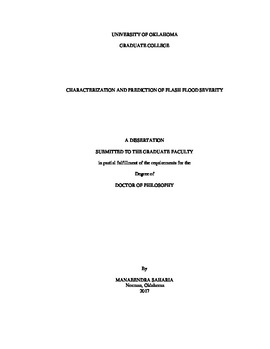| dc.description.abstract | Flash floods, a subset of floods, are a particularly damaging natural hazard worldwide due to their multidisciplinary nature, difficulty in forecasting, and fast response that limits emergency responses. The purpose of this work is to develop a framework of characterizing floods and flash floods based on a multitude of explanatory variables that describe the geology, topography, pedology, climatology, and rainfall spatial variability. Until now, flash flood characterization studies in the United States have been limited in scope due to the lack of a comprehensive database matching flood characteristics such as peak discharges and flood duration with geospatial and geomorphologic information. In this study, A long data record spanning 78 years from the United States Geological Survey (USGS) stream gauge network is combined with National Weather Service (NWS) flooding thresholds to study floods at basin and event scale, with special focus on the rise time and unit peak discharge. A new metric for flash flood severity called ‘flashiness’ is also proposed that represents the rate of rise of the hydrograph during flooding conditions and thus captures both the magnitude and timing aspects of floods.
Associations between flashiness and geophysical variables are initially constructed at locations where there is known information from both discharge observations and the geospatial datasets. These relationships are first investigated through first-order characterization of trends and their variability. Since we don’t have discharge observations everywhere, a multi-dimensional statistical modeling approach is built upon these associations to regionalize flashiness to all ungauged locations across the Continental United States (CONUS). Several localized flash flood hotspots were identified outside of the originally defined regions including the western slopes of the Appalachians in Tennessee, Kentucky, and West Virginia. Furthermore, a high-resolution Multi-Radar/Multi-Sensor (MRMS) rainfall reanalysis dataset (1 km/5-min resolution) from 2002-2011 was used to quantify the relative impact of sub-basin scale rainfall spatial variability and geomorphology on flashiness. It was found that the percentage contribution of rainfall spatial variability to flashiness is 9% more for flash floods compared to floods.
Results from this research highlight how the trend and variability of flooding variables such as rise time, unit peak discharge, flash flood severity etc. could be explained using a large number of explanatory variables. It also demonstrates how complex non-linear association between the hydrologic response and variables representing causative processes could be modeled with reasonable skill to predict in ungauged locations. | en_US |
